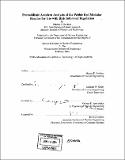| dc.contributor.advisor | Michael W. Golay. | en_US |
| dc.contributor.author | Savkina, Marina D., 1973- | en_US |
| dc.contributor.other | Massachusetts Institute of Technology. Dept. of Nuclear Engineering. | en_US |
| dc.date.accessioned | 2005-06-02T18:29:42Z | |
| dc.date.available | 2005-06-02T18:29:42Z | |
| dc.date.copyright | 2004 | en_US |
| dc.date.issued | 2004 | en_US |
| dc.identifier.uri | http://hdl.handle.net/1721.1/17748 | |
| dc.description | Thesis (S.M.)--Massachusetts Institute of Technology, Dept. of Nuclear Engineering, 2004. | en_US |
| dc.description | Includes bibliographical references (p. 75-76). | en_US |
| dc.description.abstract | One of the major challenges to the successful deployment of new nuclear plants in the United States is the regulatory process, which is largely based on water-reactor technology. While ongoing and expected efforts to license new LWR designs are based primarily on current regulations, guidance, and past licensing experience, the pre- application review of the gas-cooled Pebble Bed Modular Reactor (PBMR) has shown that efforts are being made to provide additional "risk-informed" improvements to the licensing process. The work presented herein was completed as part of the DOE Nuclear Energy Research Initiative project on a new "highly risk-informed" design and regulatory process. This study concentrates on the application of the risk-informed principles to a new plant design such as the PBMR. The purpose of this work is to provide selected examples of PRA applications, including development of Master Logic Diagram (MLD) for the selection of accident-initiating events and safety classification systems and components, as well as evaluating the risk significance of design features responsible for preventing and mitigating accidents. An implementation example chosen for a detailed analysis concentrates on the investigation of potential failure modes where performance of the novel design features such as water-based Reactor Cavity Cooling System (RCCS) is critical for the plant safety. The role and importance of the PBMR safety features is investigated by evaluating the risks from the most important external event: earthquake with a subsequent loss of offsite power. | en_US |
| dc.description.abstract | (cont.) The scope includes specifying design configurations and using PRA techniques to evaluate the design, then iterating with subsequent design changes that improve the overall level of safety and system reliability. The viability of the new risk-informed process is demonstrated. Technical results, consistent with the known inherent safety features of such a reactor design, indicate that a pressure-tight containment similar to those for today's operating reactors may not be required for the PBMR. | en_US |
| dc.description.statementofresponsibility | by Marina D. Savkina. | en_US |
| dc.format.extent | 76, A1-A11, B1-B17, C1-C14, D1-D15 p. | en_US |
| dc.format.extent | 4582123 bytes | |
| dc.format.extent | 4581932 bytes | |
| dc.format.mimetype | application/pdf | |
| dc.format.mimetype | application/pdf | |
| dc.language.iso | eng | en_US |
| dc.publisher | Massachusetts Institute of Technology | en_US |
| dc.rights | M.I.T. theses are protected by copyright. They may be viewed from this source for any purpose, but reproduction or distribution in any format is prohibited without written permission. See provided URL for inquiries about permission. | en_US |
| dc.rights.uri | http://dspace.mit.edu/handle/1721.1/7582 | |
| dc.subject | Nuclear Engineering. | en_US |
| dc.title | Probabilistic accident analysis of the Pebble Bed modular Reactor for use with risk informed regulation | en_US |
| dc.title.alternative | Probabilistic accident analysis of the PBMR for use with risk informed regulation | en_US |
| dc.type | Thesis | en_US |
| dc.description.degree | S.M. | en_US |
| dc.contributor.department | Massachusetts Institute of Technology. Department of Nuclear Engineering | en_US |
| dc.contributor.department | Massachusetts Institute of Technology. Department of Nuclear Science and Engineering | |
| dc.identifier.oclc | 56504086 | en_US |
